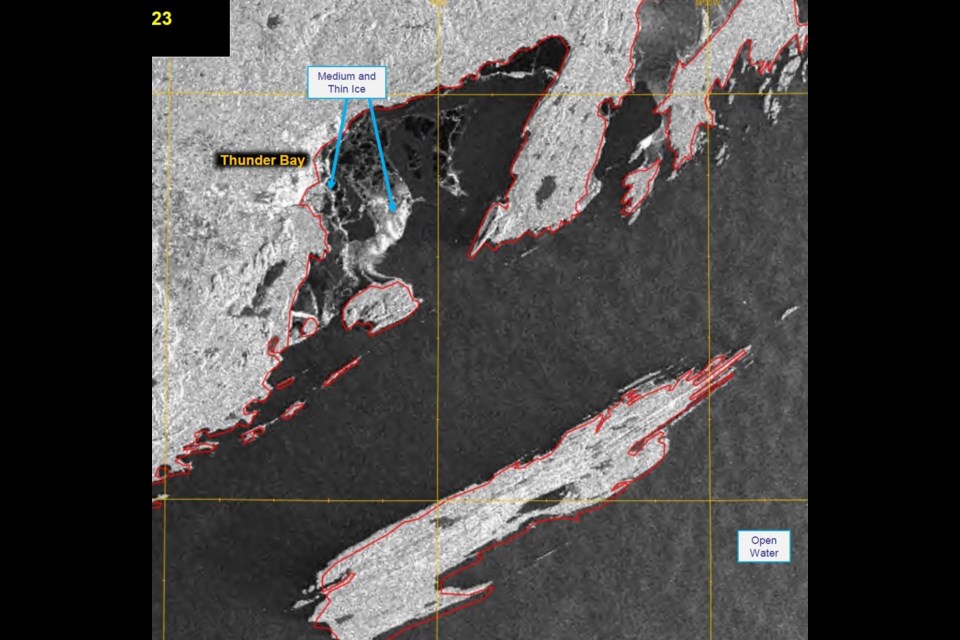THUNDER BAY — Above-average temperatures are hindering the formation of ice along most of the Lake Superior shoreline this winter, and could indicate this will be another year with little ice coverage on the open portion of the lake.
On the Canadian side, ice typically forms first in bays including Thunder Bay, Black Bay and Nipigon Bay.
George Karaganis, a senior meteorologist with the Canadian Ice Service, said the latter two are nearly completely covered with thin to medium ice, while Thunder Bay has mostly new or thin ice,"but not that much."
By definition, new ice is less than five centimetres thick, thin ice ranges from five cm to 15 cm, and medium ice is 15 cm to 30 cm thick.
Karaganis said that in a typical year, Black Bay and Nipigon Bay would be covered in medium ice at this point, while Thunder Bay would be 9/10 covered.
"And it would be thin to medium. You don't have any of that now. You have thin and new for the most part. So you're missing the thick ice."
A graph produced by the U.S. government's National Oceanic and Atmospheric Administration shows ice formation on the entirety of Lake Superior is happening at a much slower pace than normal.
Environment Canada's long-range weather forecast models currently show above-normal temperatures continuing into at least early February.
At the University of Minnesota Duluth's Large Lakes Observatory, Jay Austin has been studying Lake Superior including its ice formation for years.
In an interview Tuesday, he said an inquiry from TBnewswatch came at a convenient time as he had just been considering the outlook for ice this season.
"Air temperature is a really, really good predictor of average ice cover on the Great Lakes in general, but Superior especially. Right now we are having a relatively mild winter, and we are at a stage where it's difficult to make a prediction as to what the maximum ice coverage is going to be, but it looks like the seasonally-averaged ice coverage is likely to be on the low side this year."
Lake Superior has become one of the fastest-warming lakes in the world, and its ice cover has been reduced by an average of over 30 per cent in the last 50 years, according to the Great Lakes Environmental Research Laboratory of the U.S. National Oceanic and Atmospheric Administration.
NOAA, however, has also documented how there have been broad swings year-to-year between very little ice coverage and total coverage of the big lake.
But Austin said 1998 marked a turning point.
"This is actually documented in the literature by colleagues. There was a sort of step-change. Since 1998 we've seen predominantly low ice years. There are exceptions. 2014, which was the Polar Vortex year, was a crazy-high ice year compared with anything in the last 40 years. But with those exceptions, we tend to see more and more of these relatively low ice years."
Austin has found that the difference between a high ice year and a low ice year on Superior can be an average temperature difference of just one or two degrees Celsius.
What happens on the lake in the winter can have multiple long-range impacts, from commerce to ecology.
The absence of ice makes it easier to get the shipping season underway in the spring, but it also causes Superior's surface water to warm up in the summer and create conditions for the potential formation of blue-green algae blooms.
While noting that he's a physicist rather than a biologist, Austin said ice coverage in coastal areas is important for fish spawning and the protection of clutches of eggs, because in low ice years they are exposed to surface waves.
"There are all kinds of different effects between a low ice year and a high ice year," he said. "It's not that there won't be ice in Thunder Bay or the Duluth-Superior harbour, but on the open portions of the lake, I think we're going to see very limited ice this year."
